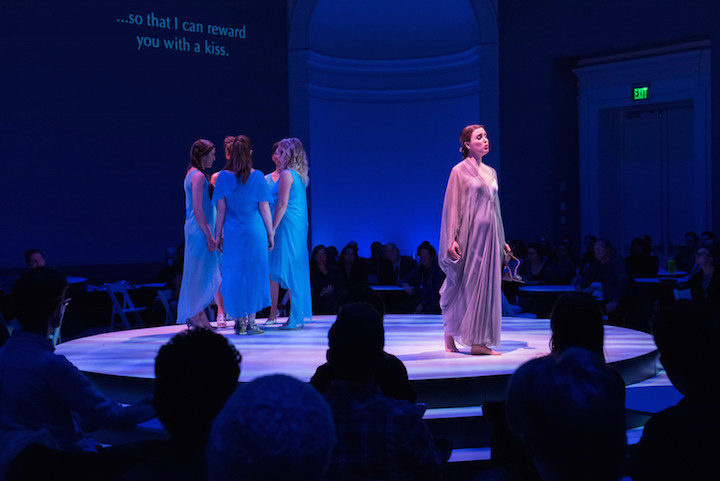
“Milica, friend, you are leaving home forever!”
And so opens the a cappella opera, Svadba-Wedding, presented by SF Opera Lab as its second program in its first season at the Taube Atrium Theater.
The hour-long chamber opera, written by Serbian composer Ana Sokolovic, portrays a bachelorette party the night before a young woman’s wedding. Sung in Serbian by six singers, the opera libretto is composed of wedding poetry from a range of periods and regions in Serbian cultural history.
The music, though, is a combination of operatic and Balkan, combining bel canto vocal technique with the close-harmonies and chest voice of the folk music that put the Bulgarian State Television Women’s Vocal Choir on the world music map. Harmonic seconds flourish in this wonderfully melded score.
To this heady vocal mix Sokolovic’s added her own wry sense of rhythm and instrumentation. Sounds are made with feet, hands, drum, cups, bottles, glasses and a bird whistle, as the story moves across six scenes of girls preparing – joyously and anxiously – for The Wedding. Language itself becomes a form of instrumentation, with words broken into vowels and consonants, creating a rhythmic vocalese that forms its own soundscape.
The opera was originally commissioned and presented by the Toronto-based Queen of Puddings Music Theater. And the musical performance was directed by one of the Music Theater’s founders, Dáirine Ni Mheadhra (pronounced DOI-ri-nuh ni-VA-rah), who moved with the six singers around the theater space to keep everyone tidily tuned and rhythmically precise.
The opera has appeared in a number of venues since its premiere in 2014, including Opera Philadelphia (2013) and the Aix-en-Province Festival. The SF Opera Lab performance was staged by Canadian Michael Cavanagh, who directed Lucia di Lammermoor and Susannah for San Francisco Opera.
Although any number of theatrical stagings could be envisioned for the Atrium Theater, the creative team used a theater-in-the round format with a central raised platform, where the first and final scenes took place. The other scenes were staged in the niches set into the surrounding walls. Formerly used for large sculpture when the Atrium was home to the Museum of Modern Art, the niches allowed plenty of room for the girls to “color” the bride’s hair, share shots of some mysterious but musical liqueur, and to compete in an alphabet game to the emphatic punctuations of a snare drum.
A catwalk hung above, just below the buildings beautifully moulded ceiling, allowed for lighting gear. Occasional heaps of shimmering fabric were dropped from ceiling to floor.
The audience sat at tables around the central platform. The tables are part of SF Opera Lab’s policy of friendly intimacy. Not only was the audience sitting in the midst of the theatrical action, they were able to bring drink and snacks to the table as well. This sort of cabaret setting was not as injurious to the music as is often the case. The audience was respectfully quiet and engaged. Taken by the poignancy of the moment.
One of the plusses of the staging was that it allowed a shifting sound among the singers. One moment you would hear Jaqueline Woodley’s sweet soprano blending with mezzo Krisztina Szabo, and then the singers would move like ponies on a carousel and you would hear soprano Laura Albino. Then Liesbeth Devos’ warm mezzo, or Pauline Sikirdji followed by Andrea Ludwig. In solo, or clustered in groups.
The supertitles of the really excellent libretto were artistically projected in the space, and lighting by Alexander V. Nichols took on the some of the burden of the acting. The various colors of the bride’s hair – “this dye takes you away from your home/ this from your father/ this from your mother” – were splashed in vibrant green, blue, red and yellow across the walls. Projections of the girls’ names drifted across the walls and the Serbian Cyrillic alphabet hovered over the alphabet game.
Similar to the a cappella setting of the music, the acting was mostly pantomimed with a minimum of environmental props and sets.
Afterwards, SF Opera Lab offered free champagne and a wedding cake of profiteroles. Yum. The backdrop of traditional funky dance music was overseen by an agreeable young dj, and the audience could mingle and talk with the composer. It was all thoroughly charming.
For this first season, SF Opera Lab is offering a range of vocal fare in several configurations. Besides Sokolovic experimental chamber opera, the season opened with baritone Matthias Goerne singing Schubert’s Winterreise in a staged media setting. Later performances include a live orchestral accompaniment to the animated film, The Triplets of Belleville; Deborah Voight in a one-woman soul-searching, developed in collaboration with Terrence McNally and Francesca Zambello, and collaborative chamber works.
– Jaime Robles
Svadba-Wedding continues through April 10. For information and tickets, visit http://sfopera.com/sfoperalab/
Photo by Stefan Cohen.
